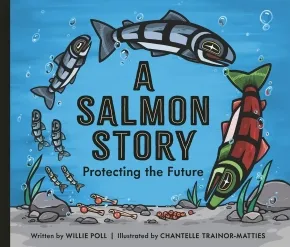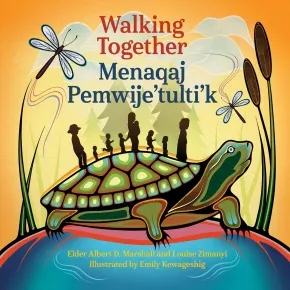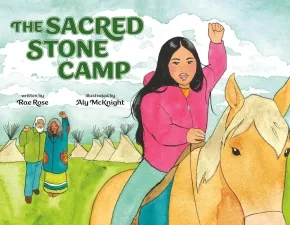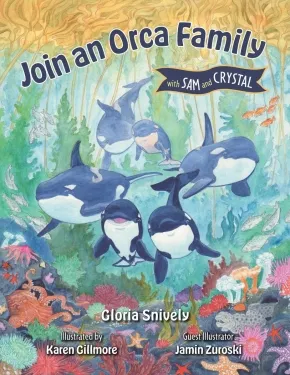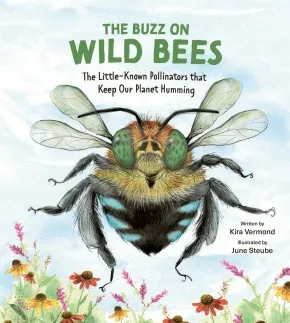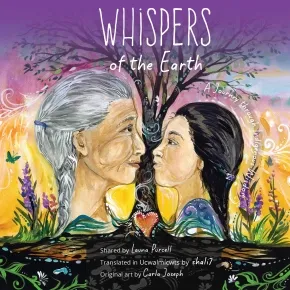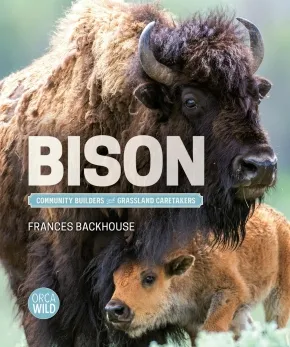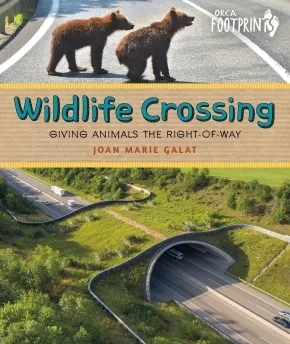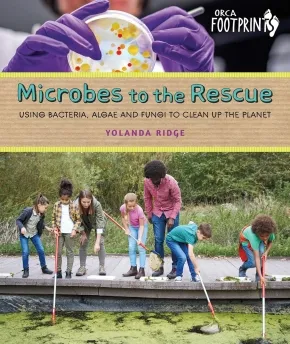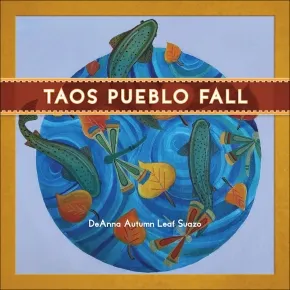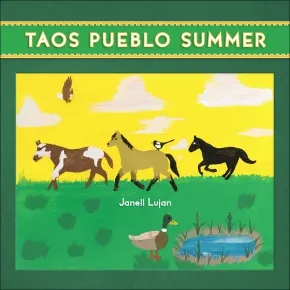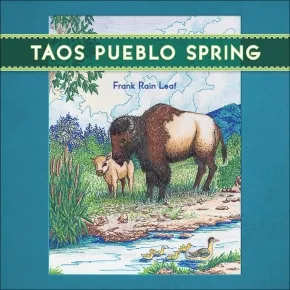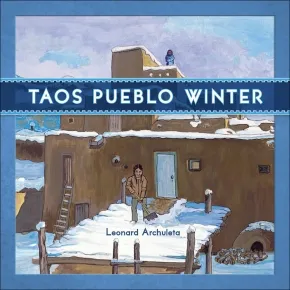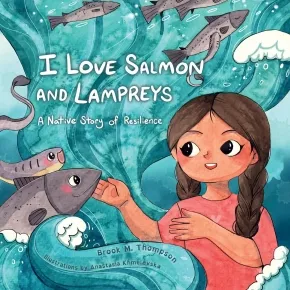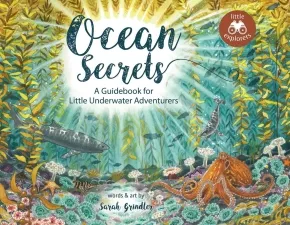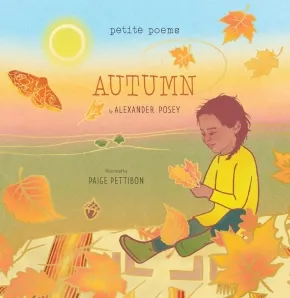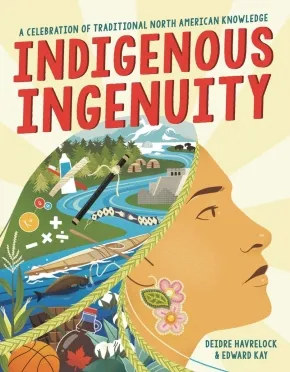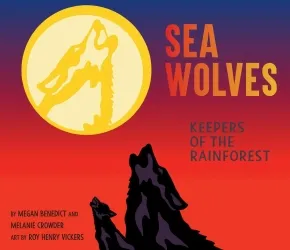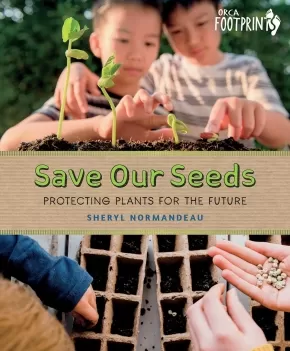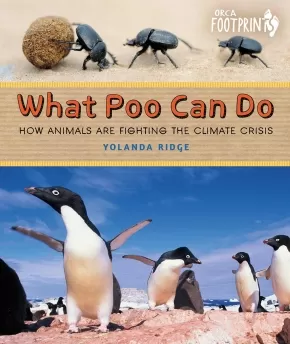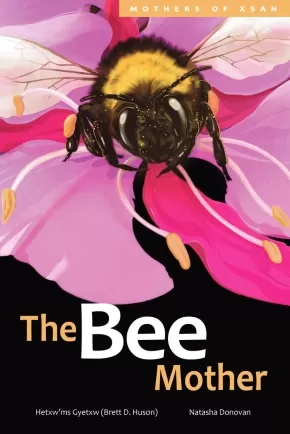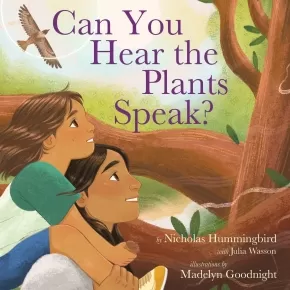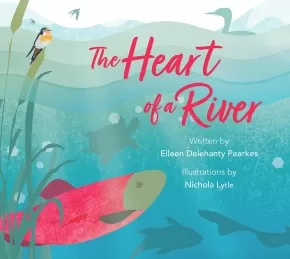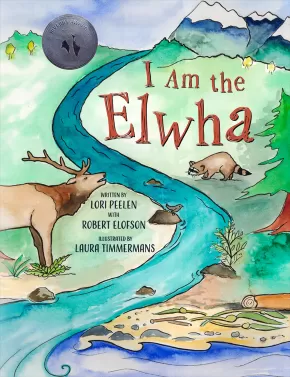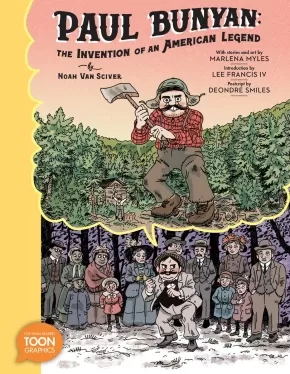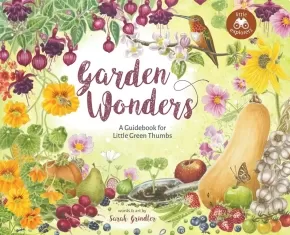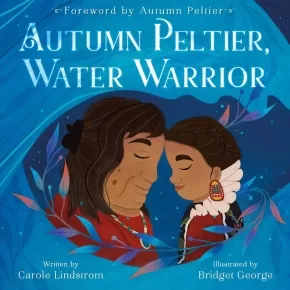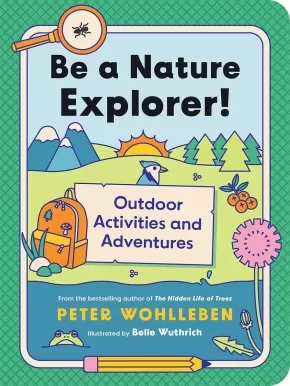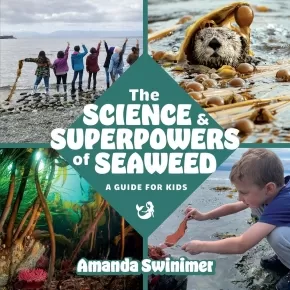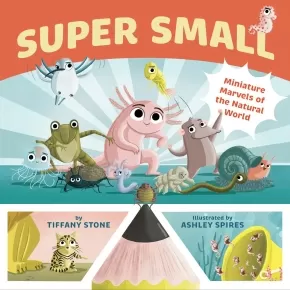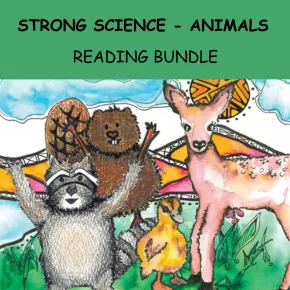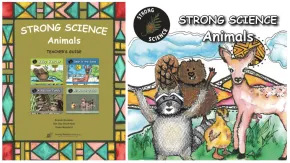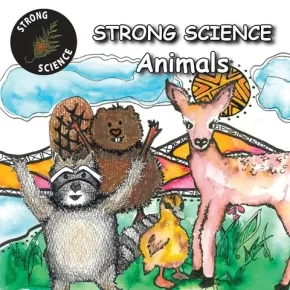
Environment
1
-
15
of
188 Results;
Sort By
Go To
of 13
A Salmon Story: Protecting the Future
$22.95
Artists:
Format:
Hardcover
Text Content Territories:
Indigenous Canadian; First Nations; Salish; Interior Salish; St'at'imc (Lillooet, Lil'Wat);
ISBN / Barcode: 9781771476461
Synopsis:
Synopsis:
A lyrical informational picture book about how open-net pen fish farms impact wild salmon and their ecosystems
Salmon are central to their ecosystem and the lives of many Indigenous Nations, but the rapid rise of open net-pen fish farming has threatened these longstanding connections. Salmon have followed the same migration routes for thousands of years, but the fish farming industry has had a deadly impact on their annual journey. Open-net pen farms release harmful waste into the ocean that is lethal to the wild salmon forced to swim through it. Now, the salmon must battle against the human-made destruction of their habitat, and many Nations are advocating for change and creating calls of action to protect salmon for future generations.
As the young salmon journey from their gravel nests to the open ocean, readers learn about the life cycle of wild salmon, the effects of open-net pen fish farms, and the role of salmon as a keystone species.
Boldly illustrated with gorgeous Northwest Coast formline art, rhythmic poetry combines with supportive nonfiction content to illuminate the struggles faced by wild salmon populations.
Educator Information
Recommended for ages 5 to 8.
Fountas & Pinnell Text Level Gradient: J
Lexile measure: 980L
Additional Information
40 pages | 10.00" x 8.50" | Hardcover
The Cedar Mother
$24.95
Artists:
Format:
Hardcover
Text Content Territories:
Indigenous Canadian; First Nations; Gitxsan (Gitksan);
ISBN / Barcode: 9781774921586
Synopsis:
Synopsis:
From small sapling to towering giant, follow the long life of a cedar tree in this illustrated book for young scientists.
Step outside to explore the hidden mysteries of the cedar tree life cycle in this beautifully illustrated, engaging non-fiction book for young scientists ages 9 to 12.
Meet Nox Sim Gan, the cedar mother, whose life cycle spans centuries and whose roots anchor the landscape. The cedar mother plays a vital role in the ecosystem: offering shelter for birds in her strong limbs, providing refuge for small creatures beneath her bark, and healing the Gitxsan with a medicinal tea made from her soft, green leaves. She also creates the very oxygen that all land-dwelling creatures need to breathe.
Delve into the remarkable story of the western red cedar as you learn how she nourishes herself through an unexpected connection to salmon, the secret web of life that thrives beneath the ground, and how, at the end of her life, she leaves a final gift for the Gitxsan. This book invites young readers to discover the life of a tree that is much more than meets the eye, offering lessons in interconnectedness, and in wisdom passed down through generations.
Educator & Series Information
Recommended for ages 9 to 12.
Lexile measure: 1050L
This book is part of the Mother of Xsan series, which uses striking illustration and lyrical language to bring the poetry of the Xsan ecosystem to life. It is the eighth book in the series.
Additional Information
32 pages | 6.50" x 10.00" | Hardcover
Walking Together / Menaqaj Pemwije’tulti’k
$24.99
Format:
Hardcover
Text Content Territories:
Indigenous Canadian; First Nations; Mi'kmaq (Mi'gmaq);
ISBN / Barcode: 9781834020174
Synopsis:
Synopsis:
This bestselling and award-winning introduction to Etuaptmumk—the gift of multiple perspectives also known as Two-Eyed Seeing—is now available in a bilingual edition that celebrates the Mi’kmaw language and our connections to nature.
Elder Albert D. Marshall is a leading environmental voice who has brought forward the concept of Etuaptmumk, honoring and braiding both Indigenous and non-Indigenous knowledges and ways of knowing for the benefit of all. Walking Together is grounded in this, as well as in the concept of Netukulimk, meaning to protect Mother Earth for the ancestors and for present and future generations. The journey in Walking Together nurtures respectful, reciprocal, responsible relationships with the Land and Water, with plant life and animals, and with other-than-human beings.
Translated by Barbara Sylliboy and Arlene Stevens, Eskasoni First Nation, Unama’ki (Cape Breton), Nova Scotia, the dual-language text in Mi’kmaw and English furthers Elder Marshall’s lifelong work preserving cultural beliefs and creating a strong vision for his people and for the future. Elder Marshall and Louise Zimanyi are working together to promote Land-based learning through storytelling, an approach that has global relevance for protecting biodiversity, climate action, and resilience. Emily Kewageshig’s evocative artwork illustrates the beauty of connecting with nature and encourages readers to strengthen their relationships to the world around them.
Educator Information
Recommended for ages 4 to 7.
Introduces the concept of Two-Eyed Seeing (the gift of multiple perspectives) to young readers.
Bilingual Edition: Mi’kmaw and English.
This book is available in English: Walking Together
Additional Information
40 pages | 9.00" x 9.00" | Hardcover
The Sacred Stone Camp
$24.99
Artists:
Format:
Hardcover
Text Content Territories:
Indigenous American; Native American; Sioux; Dakota; Lakota;
ISBN / Barcode: 9780593696637
Synopsis:
Synopsis:
A stunning account of the Sacred Stone Camp's first day, where Indigenous activist LaDonna BraveBull Allard gathered water protectors to protest the Dakota Access Pipeline
The land is sacred to the people. The people are sacred to the land.
As Water Protectors gather to defend the water and protect the land against a black snake that threatens the rivers that millions of people depend on, a young girl looks to her Unci LaDonna and Lala Miles who are leading the way to the camp.
Although she’s nervous about what might happen next, she finds strength from her family and the strangers all coming together to stand up for what’s right.
Written with love by Rae Rose, who shares many memories with LaDonna, this is a deeply moving tribute to LaDonna’s work and impact with stunning watercolor illustrations by Aly McKnight.
Educator Information
Recommended for ages 5 to 9.
Additional Information
40 pages | 11.00" x 8.50" | Hardcover
Join an Orca Family with Sam and Crystal
$29.95
Artists:
Format:
Hardcover
Text Content Territories:
Indigenous Canadian;
ISBN / Barcode: 9781038305527
Synopsis:
Synopsis:
Sam has always dreamed about being an orca, while Crystal discovers she hopes to grow up and study orcas as a marine biologist. When the siblings head to the Pacific coast to visit their aunt and uncle, they are in for a treat! Aunt Kate is a marine biologist, and she has all kinds of interesting facts to share about the Resident orca pods.
Sam and Crystal learn about the different populations of orcas and their food sources, attend the Save the Salish Sea Festival with an Indigenous woman, and have their own incredible adventure with an orca pod. They come away with a new understanding about the role they play in protecting our animal friends and what it will take to ensure that the orca pods have their own vibrant, beautiful future.
Join an Orca Family with Sam and Crystal is the fourth book in the Sam and Crystal series. It weaves a wealth of factual information about the orcas of the Pacific Northwest Coast with an entertaining story and beautiful, whimsical, biologically accurate illustrations. Children will learn basic ecology concepts while exploring the Pacific coastline right alongside Sam and Crystal.
Educator & Series Information
Recommended for ages 11 and under.
This book is part of the Explore with Sam and Crystal Series.
Additional Information
64 pages | 8.50" x 11.00" | Hardcover
The Buzz on Wild Bees: The Little-Known Pollinators that Keep Our Planet Humming
$22.95
Artists:
Format:
Hardcover
ISBN / Barcode: 9781771476171
Synopsis:
Synopsis:
An engaging introduction to the wide world of wild bees
Say the word "bee," and most kids think of honeybees or bumblebees. But there are around 20,000 discovered species of bees-and most of these are wild, solitary bees that don't live in hives. Readers will discover fascinating facts about these lesser-known bee species, from mason bees and mining bees to leafcutter bees and vulture bees.
Using clear, concise language and plenty of fun word play, this introduction to wild bees describes their life cycles, habitats, and behaviors ... some of which are weirder than others! It also explains the importance of wild solitary bees to many ecosystems, the challenges these bees face, and the things we can do to be part of the solution.
Vibrant, detailed illustrations created with pencil, crayon, and watercolor provide close-up views that are buzzing with life. Full of fun facts, The Buzz on Wild Bees invites readers to celebrate and protect all the world's bees.
Educator Information
Recommended for ages 7 to 10.
Additional Information
40 pages | 8.50" x 9.50" | Hardcover
Whispers of the Earth: A Journey through Indigenous Wisdom
$29.00
Artists:
Format:
Paperback
Text Content Territories:
Indigenous Canadian; First Nations; Salish; Interior Salish; St'at'imc (Lillooet, Lil'Wat);
ISBN / Barcode: 978-1-73869-534-8
Synopsis:
Synopsis:
Prepare to embark on a journey rich with the wisdom of our ancestors and the secrets shared by Mother Earth.
In this children’s book, you will follow a path once tread by those before us, where the songs of the trees, the dance of the rivers, and our stories are carried by the wind. These teachings are invaluable treasures passed down through generations.
You’ll discover the language of animals, the lessons of plants, and the wisdom of the land. If you listen closely, you will hear the “Whispers of the Earth,” guiding you on this incredible adventure.
Educator Information
Recommended for kindergarten to grade 7.
Carl Sam advised on the language, and is “Ha7li” of the Bear Clan from Skookumchuck, part of St’at’icmulh Nation, sometimes referred to as the Interior Salish. Through this book, he shares elements of the Ucwalmícwts language.
Includes some words in Ucwalmícwts.
Additional Information
60 pages | 20 × 20 × 1 cm | Paperback | Printed locally on 100% post-consumer recycled paper.
A Kid's Guide to Plants of the Great Lakes Region: Including Southern Ontario with Cool Facts, Activities and Recipes
$26.95
Format:
Paperback
Text Content Territories:
Indigenous Canadian;
ISBN / Barcode: 9781998526109
Synopsis:
Synopsis:
A middle-grade-friendly introduction to flora of the Great Lakes Region, with outdoor activities, games and quizzes that make learning about nature fun! Great for families and educators.
Get dirty digging up roots. Crouch down to look closely at a carnivorous sundew dissolving a dragonfly. Make an elderberry concoction. Test your plant ID skills with a winter twig quiz. Make a soothing plantain salve to treat an itch. Learn which berries you can eat and which to avoid.
Time spent outdoors encourages children’s self-confidence and independence, increases attention span and physical well-being, and fosters care for the environment. With the increasing intrusion of technology into daily life, and the challenges of climate chaos, it has never been more essential for parents and educators to encourage kids to engage with the natural environment. Plants are everywhere, even in urban areas where parks, empty lots and backyards offer the opportunity to learn from and connect to nature.
Drawing on their years of experience as outdoor educators, co-authors Philippa Joly and Danielle Gehl Hagel feature fifty richly illustrated plant profiles, including information on identification and ecology, cultural uses, and fun activities—all in a way that is accessible and interesting to readers of all ages.
Educator Information
Juvenile Nonfiction.
Additional Information
224 pages | 8.50" x 8.50" | Paperback
Bison: Community Builders and Grassland Caretakers
$24.95
Format:
Hardcover
Text Content Territories:
Indigenous American; Indigenous Canadian; First Nations; Assiniboine (Nakoda Oyadebi); Carry The Kettle Nakoda First Nation; Métis;
ISBN / Barcode: 9781459839236
Synopsis:
Synopsis:
Bison are North America’s largest land animals.
Some 170,000 wood bison once roamed northern regions, while at least 30 million plains bison trekked across the rest of the continent. Almost driven to extinction in the 1800s by decades of slaughter and hunting, this ecological and cultural keystone species supports biodiversity and strengthens the ecosystems around it. Bison: Community Builders and Grassland Caretakers celebrates the traditions and teachings of Indigenous Peoples and looks at how bison lovers of all backgrounds came together to save these iconic animals. Learn about the places where bison are regaining a hoof-hold and meet some of the young people who are welcoming bison back home.
Educator & Series Information
Recommended for ages 9 to 12.
This book is part of the Orca Wild series that examines the intricacies of animals, ecosystems, humans and our relationships to each other.
This STEAM title examines the biology and habitat of bison, their role as a keystone species, their importance to Indigenous cultures, conservation efforts, and how kids can take action to protect bison in the future.
Reading Levels:
Fountas & Pinnell Text Level Gradient: W
Lexile measure: 1020L
Guided Reading Level: W
Contains some Indigenous content, such as a contribution from Kaleya Blackbird Runns from the Carry the Kettle Nakoda Nation in Saskatchewan, as well as information on the bison's importance to many Indigenous cultures in North America.
Additional Information
96 pages | 7.50" x 9.00" | 96 colour photographs, 2 maps, 1 index, 1 bibliography | Hardcover
Wildlife Crossing: Giving Animals the Right-of-Way
$21.95
Format:
Hardcover
ISBN / Barcode: 9781459833463
Synopsis:
Synopsis:
What happens when the needs of people and nature collide?
More than 13 million miles of roads crisscross landscapes in 222 countries. Roads offer many human benefits, but they also create problems for nature. Their construction leads to a loss of biodiversity through habitat loss, fragmentation and degradation. Roads isolate wildlife populations, impede migration and allow invasive plant and animal species to spread, while giving rise to pollution from garbage, light, noise and airborne contaminants. With innovative tools, like wildlife overpasses to reconnect landscapes, smart roads and vehicles to maximize safety, and a little hands on help, we can create environmental harmony. And sitting in the passenger seat, young people can play a part in helping highways and habitats coexist.
Reviews
“Well organized and includes clearly explained examples from many locations…This volume offers considerably more information for students researching the topic. An intriguing subject and a good resource for middle-grade reports.”— Booklist
“Gorgeous, crisp photographs complement the well-written text…A first purchase for libraries that need more books on the topic of conservation and the impact of development on wildlife.” — School Library Journal (SLJ)
“A fascinating, invaluable and enlightening tool for libraries, schools and homes alike. Wildlife Crossing will empower all readers to do their part when it comes to road ecology and will undoubtedly spark meaningful conversations about what it means to coexist with nature. Very highly recommended.”— Canadian Children's Book Centre (CCBC) Canadian Children’s Book News
“Wildlife Crossing gives an intriguing overview of the topic in just 48 pages, but it is a good addition to science collections with a focus on the environment. Highly Recommended.”— CM: Canadian Review of Materials
Educator & Series Information
Recommended for ages 9 to 12.
This book is part of the Orca Footprint series.
Reading Levels:
Fountas & Pinnell Text Level Gradient: X
Lexile measure: 1130L
Guided Reading Level: X
Additional Information
48 pages | 8.00" x 9.50" | Includes 74 colour photographs, 1 index, 1 bibliography | Hardcover
Our Plastic Problem: A Call for Global Solutions
$21.95
Format:
Hardcover
ISBN / Barcode: 9781459836709
Synopsis:
Synopsis:
We have a serious plastic problem.
What was supposed to be a miracle material when it was first invented is now one of the biggest sources of pollution on our planet. But where does plastic come from? Why do we use so much of it? How does it hurt the environment and the animals who live there? Our Plastic Problem looks at plastic's history, uses, and how it affects land, water, air and human health. It also explores innovations in bioplastic and recycling, and practical ways to reduce and replace the plastic in our lives. Working together, we can solve our plastic problem.
Reviews
“Like other books in the Orca Footprints series, this volume is accessible, broadly informative, and illustrated with many pertinent color photos. A timely introduction to a serious environmental issue.” — Booklist
“Durnford effectively communicates a sense of urgency. Young eco-activists will also find general guidelines for localized projects, as well as specific instructions for laundering clothing to reduce microfibre shedding, among other immediately applicable advice. Accentuates the positive without minimizing the issue’s scope.” — Kirkus Reviews
“This is a great introduction to the history of plastics. Very informative and written at a level that is digestible for young readers. Would work well with a study unit. Hand this book to budding environmentalists or anyone interested in learning more about the plastic problem. A recommended purchase for updating nonfiction collections.” — School Library Journal (SLJ)
Educator & Series Information
Recommended for ages 9 to 12.
This book is part of the Orca Footprint series.
Reading Levels:
Fountas & Pinnell Text Level Gradient: X
Lexile measure: 1070L
Guided Reading Level: X
Additional Information
48 pages | 8.00" x 9.50" | Includes 78 colour photographs, 1 index, 1 bibliography | Hardcover
Microbes to the Rescue: Using Bacteria, Algae and Fungi to Clean Up the Planet
$21.95
Format:
Hardcover
ISBN / Barcode: 9781459839137
Synopsis:
Synopsis:
Microbes are tiny but mighty, and they're everywhere!
When left alone, microbes such as bacteria, fungi and algae are experts at adapting, surviving and thriving under extreme and constantly changing conditions. These natural problem solvers can help fight the climate crisis by gobbling up pollutants, breaking down plastic, generating clean energy and capturing carbon. By harnessing the power of microbes, we can create eco-friendly packaging, farm-free food, and even make it easier to live in space! Microbes to the Rescue will introduce young readers to life on a microscopic level and explore how bacteria, fungi and algae play a key role in the connection between all life on Earth. Let’s get microscopic and learn about how microbes can create a cleaner and more sustainable future.
Educator & Series Information
Recommended for ages 9 to 12.
This book is part of the Orca Footprint series.
Reading Levels:
Fountas & Pinnell Text Level Gradient: X
Lexile measure: 1110L
Guided Reading Level: X
Additional Information
56 pages | 8.00" x 9.50"| Includes 63 colour photographs, 1 index, 1 bibliography | Hardcover
When a Tree Falls: Nurse Logs and Their Incredible Forest Power
$28.99
Artists:
Format:
Hardcover
ISBN / Barcode: 9781797218670
Synopsis:
Synopsis:
The perfect read for exploring nature with children, this beautiful nonfiction picture book offers an awe-inspiring look at the forest’s life cycle.
A tree suns and sways in the forest. She is a place to grow, to rest, and to shelter. But what happens when a tree falls? The answer will make your heart soar. In this lyrical picture book, explore how the extraordinary nurse log provides a nutrient-rich space for new seedlings, shelters small animals, hosts different plant species, and, most profoundly, nurtures a new tree in the process, renewing the cycle of life. Young readers will be amazed by the nurse log’s resilience and its powerful connection to the forest’s past, present, and future.
Perfect for:
- Kids who are interested in trees and forests
- Parents and grandparents of children who want to learn more about trees and forests
- Teachers, educators, and librarians seeking beautiful nonfiction books with STEM content
- Gift-givers looking for a distinctive present for an animal- or nature-loving child
- Anyone seeking a picture book that promotes environmental awareness
Educator Information
Recommended for ages 6 to 9.
Every organism in the forest ecosystem is connected. This fascinating picture book powerfully illustrates how the end of one life in the forest can be the beginning of another.
When a Tree Falls is a reminder of the wondrous ecosystems in our own backyards and the wild forest beauty we may discover by looking closely. It is ideal for families who enjoy being in nature.
The forest life is rendered with such richness and detail that it invites readers to immerse themselves in the endlessly inspiring natural world.
An excellent choice for a classroom book or as a gift for kids who love trees, spending time outdoors, and are mindful of environmental issues.
Additional Informationb
Taos Pueblo Fall (BB)
$14.95
Artists:
Format:
Board Book
Text Content Territories:
Indigenous American; Native American; Taos Pueblo;
Grade Levels: Preschool;
ISBN / Barcode: 9781570673917
Synopsis:
Synopsis:
This delightful board book, written without text, was created by the Taos Pueblo's Tiwa Language Program to preserve the Tiwa culture and revitalize the Tiwa language by teaching it to younger generations. Many other Indigenous languages also need revitalizing, so it is the hope of the Taos Pueblo's Tiwa Language Program that other American Indian Nations will find the books in the Toas Pueblo Four Seasons series useful to teach their language to young children. The beautiful, hand-drawn illustrations will also teach young children about the four seasons of the year. All proceeds of the book support the Taos Pueblo's Tiwa Language Program.
This text-free board book allows Indigenous nations to teach their own languages to children.
Educator & Series Information
This wordless book is part of the Taos Pueblo Four Seasons series.
We are the "Red Willow People" of Taos Pueblo and have sustained our ancient village as one of the longest continuously inhabited communities, for over 1,000 years. Taos Pueblo is located in northern New Mexico and our Tiwa language is a dialect of the Tanoan language, which is not a written language. Traditionally we learn our Tiwa Language through oral tradition but we are in danger of losing our ancient language due to colonization, modernization, and the shift from Tiwa as our first language to English as our first language. The efforts of the Taos Pueblo Tiwa Language Program are focused on revitalizing the Tiwa Language and culture by protecting and preserving it, through teaching it to our younger generations.
This text-free board book allows Indigenous nations to teach their own languages to children.
Additional Information
22 pages | 8" x 8" | Board Book
Taos Pueblo Summer (BB)
$14.95
Artists:
Format:
Board Book
Text Content Territories:
Indigenous American; Native American; Taos Pueblo;
Grade Levels: Preschool;
ISBN / Barcode: 9781570673696
Synopsis:
Synopsis:
This delightful board book, written without text, was created by the Taos Pueblo's Tiwa Language Program to preserve the Tiwa culture and revitalize the Tiwa language by teaching it to younger generations. Many other Indigenous languages also need revitalizing, so it is the hope of the Taos Pueblo's Tiwa Language Program that other American Indian Nations will find the books in the Toas Pueblo Four Seasons series useful to teach their language to young children. The beautiful, hand-drawn illustrations will also teach young children about the four seasons of the year. All proceeds of the book support the Taos Pueblo's Tiwa Language Program.
This text-free board book allows Indigenous nations to teach their own languages to children.
Educator & Series Information
This wordless book is part of the Taos Pueblo Four Seasons series.
We are the "Red Willow People" of Taos Pueblo and have sustained our ancient village as one of the longest continuously inhabited communities, for over 1,000 years. Taos Pueblo is located in northern New Mexico and our Tiwa language is a dialect of the Tanoan language, which is not a written language. Traditionally we learn our Tiwa Language through oral tradition but we are in danger of losing our ancient language due to colonization, modernization, and the shift from Tiwa as our first language to English as our first language. The efforts of the Taos Pueblo Tiwa Language Program are focused on revitalizing the Tiwa Language and culture by protecting and preserving it, through teaching it to our younger generations.
This text-free board book allows Indigenous nations to teach their own languages to children.
Additional Information
22 pages | 8" x 8" | Board Book
Taos Pueblo Spring (BB)
$14.95
Artists:
Format:
Board Book
Text Content Territories:
Indigenous American; Native American; Taos Pueblo;
Grade Levels: Preschool;
ISBN / Barcode: 9781570674143
Synopsis:
Synopsis:
This delightful board book, written without text, was created by the Taos Pueblo's Tiwa Language Program to preserve the Tiwa culture and revitalize the Tiwa language by teaching it to younger generations. Many other Indigenous languages also need revitalizing, so it is the hope of the Taos Pueblo's Tiwa Language Program that other American Indian Nations will find the books in the Toas Pueblo Four Seasons series useful to teach their language to young children. The beautiful, hand-drawn illustrations will also teach young children about the four seasons of the year. All proceeds of the book support the Taos Pueblo's Tiwa Language Program.
This text-free board book allows Indigenous nations to teach their own languages to children.
Educator & Series Information
This wordless book is part of the Taos Pueblo Four Seasons series.
We are the "Red Willow People" of Taos Pueblo and have sustained our ancient village as one of the longest continuously inhabited communities, for over 1,000 years. Taos Pueblo is located in northern New Mexico and our Tiwa language is a dialect of the Tanoan language, which is not a written language. Traditionally we learn our Tiwa Language through oral tradition but we are in danger of losing our ancient language due to colonization, modernization, and the shift from Tiwa as our first language to English as our first language. The efforts of the Taos Pueblo Tiwa Language Program are focused on revitalizing the Tiwa Language and culture by protecting and preserving it, through teaching it to our younger generations.
This text-free board book allows Indigenous nations to teach their own languages to children.
Additional Information
22 pages | 8" x 8" | Board Book
Taos Pueblo Winter (BB)
$14.95
Artists:
Format:
Board Book
Text Content Territories:
Indigenous American; Native American; Taos Pueblo;
Grade Levels: Preschool;
ISBN / Barcode: 9781570673450
Synopsis:
Synopsis:
This delightful board book, written without text, was created by the Taos Pueblo's Tiwa Language Program to preserve the Tiwa culture and revitalize the Tiwa language by teaching it to younger generations. Many other Indigenous languages also need revitalizing, so it is the hope of the Taos Pueblo's Tiwa Language Program that other American Indian Nations will find the books in the Toas Pueblo Four Seasons series useful to teach their language to young children. The beautiful, hand-drawn illustrations will also teach young children about the four seasons of the year. All proceeds of the book support the Taos Pueblo's Tiwa Language Program.
This text-free board book allows Indigenous nations to teach their own languages to children.
Educator & Series Information
This wordless book is part of the Taos Pueblo Four Seasons series.
We are the "Red Willow People" of Taos Pueblo and have sustained our ancient village as one of the longest continuously inhabited communities, for over 1,000 years. Taos Pueblo is located in northern New Mexico and our Tiwa language is a dialect of the Tanoan language, which is not a written language. Traditionally we learn our Tiwa Language through oral tradition but we are in danger of losing our ancient language due to colonization, modernization, and the shift from Tiwa as our first language to English as our first language. The efforts of the Taos Pueblo Tiwa Language Program are focused on revitalizing the Tiwa Language and culture by protecting and preserving it, through teaching it to our younger generations.
This text-free board book allows Indigenous nations to teach their own languages to children.
Additional Information
22 pages | 7.90" x 7.90" | Board Book
I Love Salmon and Lampreys: A Native Story of Resilience
$30.95
Artists:
Format:
Hardcover
Text Content Territories:
Indigenous American; Native American; Karuk; Yurok;
ISBN / Barcode: 9781597146685
Synopsis:
Synopsis:
For young readers, an inspiring story about a river, a successful Native-led movement for environmental justice, and the making of a scientist.
Growing up in the Yurok and Karuk Tribes, Brook Thompson learned to care for the fish that nurtured her and her family. She knew that along the Klamath River in Northern California, salmon and lampreys are a needed part of life. But she also saw how these fish were in danger. People had built dams along the Klamath River, making it very hard for salmon and lampreys to live. Tribal people and their friends organized to have four of the dams removed, and they won. In I Love Salmon and Lampreys, Thompson tells this inspiring tale, and she shares how it motivated her to become a scientist. Featuring adorable illustrations by Anastasia Khmelevska, as well as fun facts about salmon and lampreys, this is a stirring story about stewarding nature for the generations to come.
Reviews
"[Brook Thompson] compares these salmon transitions to her own life, sharing how she left her family to go out to university to learn how to protect salmon and lampreys and then came home to fight for conservation rights as an engineer and scientist. Maps, back matter, and fun facts enhance this satisfying, engaging story." —Booklist
"A powerful story about protesting for positive changes that protect the environment." —Kids Bookshelf
"The book not only celebrates the resilience of the Klamath River and its inhabitants but also highlights the profound impact of environmental justice on the lives of individuals and communities. It is a powerful reminder that we all have a role to play in protecting our planet and ensuring a healthy future for generations to come." —Mama Likes This
Educator Information
Recommended for ages 4 to 8.
Additional Information
32 pages | 9.00" x 9.00" | Hardcover
Ocean Secrets: A Guidebook for Little Underwater Adventurers
$20.95
Artists:
Format:
Hardcover
ISBN / Barcode: 9781774713600
Synopsis:
Synopsis:
The newest book in the Little Explorers series takes young readers from the seashore to the ocean floor, finding fascinating plants and animals and solving ocean mysteries along the way.
Let's meet some of the amazing sea life that calls the ocean home.
What creatures live where there is no sunlight? How do tides work? Is coral a plant or an animal? Search for the answers to these questions and more in the newest book in the Little Explorers series! With engaging text and realistic illustrations, young readers will adventure through the fascinating underwater world of our planet's oceans.
Learn why some sea creatures glow, and how sharks can be as small as a pencil or as long as a bowling lane. From the helpful kelp forests of the shallow sunlight zone to the cold depths of the abyssal zone, interesting plants and animals abound—and many mysteries too.
Let's dive in!
Educator & Series Information
Recommended Ages: 4-8
This book is part of the Little Explorers Series.
Additional Information
32 pages | 8.00" x 6.50" | Hardcover
Autumn
$19.99
Artists:
Format:
Hardcover
Text Content Territories:
Indigenous American; Native American; Muscogee (Creek);
Grade Levels: Preschool; Kindergarten;
ISBN / Barcode: 9781949480580
Synopsis:
Synopsis:
Discover the power of poetry in this simple, modern introduction to Indigenous poet Alexander Posey, featuring an ode to autumn and the changing seasons
Autumn depicts a dreamy fall day full of jaybird songs and scarlet leaves dancing through the air. In this poem, Muscogee poet Alexander Posey celebrates the changing of the seasons as the golden sun sets on summer and the world prepares for a time of rest. With stunning illustrations from Salish artist Paige Pettibon and interactive back matter that encourages young readers to create their own poetry, this accessible picture book is a joy for young poets and their parents alike.
Reviews
"A dreamy, succinct poem across many pages that all together encapsulates the sense of fall. A strong first purchase. The poem and artwork, which create an exquisite sense of a child’s joy in playing on an autumn afternoon, will appeal to all ages." — School Library Journal
Educator Information
Recommended for ages 3 to 5.
Additional Information
24 pages | 8.00" x 8.00" | Hardcover
Indigenous Ingenuity: A Celebration of Traditional North American Knowledge (PB)
$12.99
Artists:
Format:
Paperback
ISBN / Barcode: 9780316413435
Synopsis:
Synopsis:
Celebrate Indigenous thinkers and inventions with this beautifully designed, award-winning interactive nonfiction book—perfect for fans of Braiding Sweetgrass.
Corn. Chocolate. Fishing hooks. Boats that float. Insulated double-walled construction. Recorded history and folklore. Life-saving disinfectant. Forest fire management. Our lives would be unrecognizable without these, and countless other, scientific discoveries and technological inventions from Indigenous North Americans.
Spanning topics from transportation to civil engineering, hunting technologies, astronomy, brain surgery, architecture, and agriculture, Indigenous Ingenuity is a wide-ranging STEM offering that answers the call for Indigenous nonfiction by reappropriating hidden history. The book includes fun, simple activities and experiments that kids can do to better understand and enjoy the principles used by Indigenous inventors. Readers of all ages are invited to celebrate traditional North American Indigenous innovation, and to embrace the mindset of reciprocity, environmental responsibility, and the interconnectedness of all life.
Reviews
"An astonishing, exuberant treasure trove of history, science and hands-on activities that repeatedly begs the question: "Why didn't I know this?" Essential for kids and adults. We need this book." —Candace Fleming, award-winning author of The Rise and Fall of Charles Lindbergh and The Family Romanov
"This book will amaze readers and teachers as it demonstrates how pervasive and critical the history of Indigenous people is. A completely unique and important narrative not to be missed; readers and teachers will come away with a new appreciation for the myriad contributions Indigenous people have made."—SLJ, starred review
"A conversational tone invites readers to engage with this monumental collection . . . Curious readers will learn facts unique to individual tribal groups while gaining knowledge of STEM/STEAM concepts. An ambitious, appealing, and accessible work documenting and protecting valuable knowledge."—Kirkus Reviews
"Engaging and informative, this will be welcomed by both STEM and social studies curricula to help to correct prevailing narratives about Indigenous technology."—Booklist, starred review
"Via authoritative, meticulously researched prose, the creators detail Native peoples’ significant strides in scientific pursuits . . . [and] showcase Native tribes’ continual and enduring impact. Photographs, as well as interactive activities detailing recipes and science experiments, feature throughout, lending a hands-on approach to this clear and concise work."—Publishers Weekly
"This book is a valuable contribution to efforts to decolonize learning and introduce readers to the breadth of indigenous knowledge as practiced in widely disparate geographic zones."—Canadian Review of Materials
"An engaging and cleverly compiled guide to North American and Mesoamerican Indigenous innovation. STEM topics (housing, medicine, clothing, agriculture, and hunting among them) are compellingly and conversationally discussed."—Shelf Awareness
Educator Information
Recommended for ages 8 to 12.
Fountas & Pinnell Text Level Gradient: Z
Additional Information
288 pages | 6.95" x 9.00" | Paperback
Sea Wolves: Keepers of the Rainforest
$24.99
Format:
Hardcover
Text Content Territories:
Indigenous American; Indigenous Canadian;
ISBN / Barcode: 9781662620119
Synopsis:
Synopsis:
This lyrical, stunningly illustrated book explores the sea wolf—an apex marine mammal evolved from the gray wolf—as it navigates the coastline, eats seafood, and lives its extraordinary, unusual life.
Sea Wolves: Keepers of the Rainforest is the astonishing story of a wolf species that calls the shores of western Canada and southeastern Alaska home. Here, wolves crack clams, feast on fish roe, swipe salmon from rivers, and swim miles between islands—as long observed by the First Nations communities that have lived alongside them for thousands of years.
However, with the rise of industrial logging, pipeline projects, and other threats, sea wolves face a troubled future. Wildlife experts and First Nations members agree: these majestic creatures are a vital part of the ecosystem and need to be protected.
Through beautiful verse and striking illustrations, Sea Wolves captures the fascinating life of an animal with great cultural and scientific significance—one that will inspire awe in young readers.
Educator Information
Recommended for ages 4 to 8.
Story Locale: Coast of western Canada and southeastern Alaska; British Columbia; First Nations territory
Additional Information
32 pages | 11.31" x 9.81" | Hardcover
Walking Together (PB)
$12.99
Format:
Paperback
Text Content Territories:
Indigenous Canadian; First Nations; Mi'kmaq;
ISBN / Barcode: 9781773217772
Synopsis:
Synopsis:
This bestselling, innovative picture book introduces readers to the concept of Etuaptmumk—or Two-Eyed Seeing, the gift of multiple perspectives in the Mi’kmaw language—as we follow a group of young children connecting to nature as their teacher.
A poetic, joyful celebration of the Lands and Waters as spring unfolds: we watch for Robin's return, listen for Frog's croaking, and wonder at maple tree's gift of sap. Grounded in Etuaptmumk, also known as Two-Eyed Seeing—which braids together the strengths of Indigenous and non-Indigenous ways of knowing—and the Mi’kmaq concept of Netukulimk—meaning to protect Mother Earth for the ancestors, present, and future generations—Walking Together nurtures respectful, reciprocal, responsible relationships with the Land and Water, plant-life, animals and other-than-human beings for the benefit of all.
Reviews
"Walking Together is a poetic celebration grounded in Etuaptmumk (Two-Eyed Seeing) that weaves together the strengths of Indigenous and non-Indigenous ways of knowing. The story explores respectful, reciprocal, responsible relationships between the land, water, plants, animals, and humans." - The Dalai Lama Center
Educator Information
Recommended for ages 4 to 7.
Introduces the concept of Two-Eyed Seeing (the gift of multiple perspectives) to young readers.
This book is available in a bilingual format: Walking Together / Menaqaj Pemwije’tulti’k
Additional Information
36 pages | 8.90" x 8.90" | Paperback
It Is Good to Live in Beautiful Arctic Bay
$16.95
Artists:
Format:
Paperback
Text Content Territories:
Indigenous Canadian; Inuit;
Grade Levels: Preschool; Kindergarten;
ISBN / Barcode: 9781774507933
Synopsis:
Synopsis:
Lucy loves living in Arctic Bay. There are so many things to do in each season! In the winter during "the great darkness," Lucy likes watching the northern lights. She is always excited to welcome the sun back in the spring. In the summer, Lucy can't wait to go blueberry picking, camping, and eat pissi. Follow along with Lucy as she takes readers through the seasons and shares all her favourite things about living in beautiful Arctic Bay.
Educator & Series Information
Recommended for ages 3 to 5.
Dual-Language: English and Inuktitut.
This book is part of the Community Connections series.
Additional Information
29 pages | 9.00" x 8.00" | Paperback
Save Our Seeds: Protecting Plants for the Future
$21.95
Format:
Hardcover
ISBN / Barcode: 9781459836976
Synopsis:
Synopsis:
Small but mighty. Learn about the importance of seeds and how saving and conserving them for the future is key to sustaining healthy life on the planet.
Seeds are essential to all life on the planet. They provide us with food, clothing and other materials we need and use every day. Without seeds, the planet wouldn't have as many species of plants as we do now. Without plants, there wouldn't be oxygen to breathe and there would be less food for all life on Earth. But today seeds are under threat, mostly from human activity. The climate crisis and food insecurity mean protecting our seeds is more important than ever. In Save Our Seeds, young readers will hear from experts in the field and learn how to take action to preserve seeds for the future.
Reviews
“The latest volume in the well-regarded Orca Footprints series presents a broad array of information about seeds…Exploring seeds more broadly than most children’s books on the topic, this volume encourages readers to collect, plant, and share seeds—a small, yet powerful resource.”- Booklist
“Author and master gardener Sheryl Normandeau… emphasizes the importance of saving and conserving seeds for the future in order to sustain healthy life on Earth. Highly Recommended.”- CM: Canadian Review of Materials
Educator & Series Information
Recommended for ages 9 to 12.
This book is part of the Orca Footprint series.
Reading Levels:
Fountas & Pinnell Text Level Gradient: X
Lexile measure: 1040L
Guided Reading Level: X
Additional Information
48 pages | 8.00" x 9.50" | Includes 60 colour photographs, 1 index, 1 bibliography | Hardcover
Get Outside!: How Humans Connect with Nature
$21.95
Format:
Hardcover
ISBN / Barcode: 9781459836877
Synopsis:
Synopsis:
We know spending time in nature is good for us, but why? And how did people become so disconnected from the natural world, anyway?
Get Outside! How Humans Connect with Nature explores the important relationship between people and nature. It asks big questions, like Are humans part of nature or separate from it? and Do all people have equal access to nature? By discussing global issues such as the climate crisis and environmental racism, the book shows us that, by strengthening our relationship with the natural world, we can learn how to take care of the environment and to let the environment take care of us too.
Reviews
“Payne argues that humans are part of nature and should be engaging with the natural world more often and more effectively…Informative and likely to spur readers to forge a stronger bond with the natural world.”— Kirkus Reviews
“The text is visually striking…This book should appeal to readers interested in or curious about the outdoors and could lead to deeper engagement or activism.”— School Library Journal (SLJ)
Educator & Series Information
Recommended for ages 9 to 12.
This book is part of the Orca Footprint series.
Reading Levels:
Fountas & Pinnell Text Level Gradient: X
Lexile measure: 1030L
Guided Reading Level: X
Additional Information
48 pages | 8.00" x 9.50" | Includes 49 colour photographs, 1 index, 1 bibliography | Hardcover
What Poo Can Do: How Animals Are Fighting the Climate Crisis
$21.95
Format:
Hardcover
ISBN / Barcode: 9781459835412
Synopsis:
Synopsis:
We all know animals are affected by the climate crisis. But did you know the climate crisis is also affected by animals?
From whales to dung beetles, What Poo Can Do explores how animals big and small are helping the planet every time they do a number two. Come on a journey to different parts of the world to see how animals are fertilizing plants, storing carbon, preventing fires, reducing methane and even creating color-coded maps—all through their feces! Readers will discover how animal defecation makes a difference when it comes to the climate crisis. It's time to embrace the power of poo!
Reviews
“Well-organized and sustains the reader’s interest…Highly recommended.”— CM: Canadian Review of Materials
“While most environmental titles for children focus on how humans can protect and care for the planet, this book focuses on animals who are already assisting the cause—with poop!”— Booklist
Educator & Series Information
Recommended for ages 9 to 12.
This book is part of the Orca Footprint series.
Reading Levels:
Fountas & Pinnell Text Level Gradient: X
Lexile measure: 1090L
Guided Reading Level: X
Big Ideas & Themes: Environmental Awareness, Climate Change, Environmental Conservation & Protection, Green Issues, Sustainability, Wildlife
Additional Information
48 pages | 8.00" x 9.50" | Includes 41 colour photographs, 1 diagram, 1 index, 1 bibliography | Hardcover
The Bee Mother
$24.95
Artists:
Format:
Hardcover
Text Content Territories:
Indigenous Canadian; First Nations; Gitxsan (Gitksan);
ISBN / Barcode: 9781774920800
Synopsis:
Synopsis:
Discover the important role of bumblebees, honeybees, and wasps as pollinators in this colourful picture book for young scientists.
Learn about the life cycles of different kinds of bees in this enlightening picture book.
As flowers and trees begin to bud and bloom, Nox Ap, the bee mother, emerges from her winter sleep. To the Gitxsan, she is nature’s gardener. Without her hard work as a pollinator, we could not enjoy the fruits of strawberries and huckleberries. Follow her life from the first thaw of spring to the end of autumn.
In the seventh book of Hetxw'ms Gyetxw (Brett D. Huson)’s Mothers of Xsan series, readers will discover the important role of the bumblebee, the honeybee, and the yellow jacket wasp in the Xsan ecosystem.
Reviews
“Described with delicious adjectives (“pillowy moss floor”) that enrich the story...lushly colored and detailed; the fur on the bumblebee looks ready to be brushed. This great blend of nonfiction with narrative and amazing illustrations will engage readers in the life of bees and their significance to the Gitxsan Nation. A solid general purchase.” — School Library Journal
Educator & Series Information
Recommended for ages 9 to 12.
This book is part of the Mother of Xsan series, which uses striking illustration and lyrical language to bring the poetry of the Xsan ecosystem to life. It is the seventh book in the series.
Reading Level: Fountas & Pinnell T
Lexile® Framework for Reading: 1140L
Recommended in the Indigenous Books for Schools catalogue as a valuable resource for English Language Arts and Science in grades 2 to 6.
Themes: Animals, Land, Language, Sustainability, Life Cycles, Biodiversity, Interdependence, Seasons
Additional Information
32 pages | 6.50" x 10.00" | Hardcover
Can You Hear the Plants Speak?
$24.99
Artists:
Format:
Hardcover
Text Content Territories:
Indigenous American; Native American; Apache; Cahuilla;
ISBN / Barcode: 9780063221284
Synopsis:
Synopsis:
Our people believe spirit lives in everything.
Mountain, river, wind, tree.
Come, take a walk with me.
What do we learn from plants when we listen to them speaking? Indigenous plantsman Nicholas Hummingbird calls on the legacy of his great-grandparents to remember how one drop of rain, one seed, one plant can renew a cycle of hope and connection—for him and for each of us.
Perfect for readers of Sy Montgomery, debut authors Nicholas Hummingbird and Julia Wasson joyfully proclaim even the youngest person can be an earth protector. With gorgeous illustrations from Rock Your Mocs artist Madelyn Goodnight, Can You Hear the Plants Speak? encourages us to engage with the natural world.
Educator Information
Recommended for ages 4 to 8.
Additional Information
40 pages | 10.00" x 10.00" | Hardcover
The Heart of a River
$18.00
Artists:
Format:
Paperback
Text Content Territories:
Indigenous American; Native American; Salish; Interior Salish; Sinixt; Indigenous Canadian; First Nations; Salish; Interior Salish; Sinixt;
ISBN / Barcode: 9781771607001
Synopsis:
Synopsis:
This is a book for anyone, of any age, who cares about rivers.
This story of the Columbia River is unique. Told from the river’s perspective, it is an immersive, empathetic portrait of a once-wild river and of the Sinixt, a First People who lived on the mainstem of this great western river for thousands of years and continue to do so even though Canada declared them “extinct” in 1956.
The book’s re-release comes at a critical time for natural systems and for reconciliation with Indigenous Peoples across North America. The Colville Confederated Tribes, representing over 3,000 Sinixt People, recently won a precedent-setting case in the Supreme Court of Canada affirming that Aboriginal Rights do not stop at the border. The important story of the Sinixt weaves together with the ongoing ecological impact of hydropower development on the Columbia and its tributaries.
Central to the story is the joyous spirit of salmon, once a free swimmer in the Columbia’s currents north of the border but now blocked from ancestral spawning grounds by Grand Coulee and other dams. Restoring migratory fish indigenous to the Upper Columbia will require transboundary cooperation. With Indigenous Nations on both sides of the US–Canada border now leading the way, many are hopeful that the fish will return.
Lavishly illustrated by Nelson, BC, designer Nichola Lytle, this portrait of a globally significant river will inspire anyone who reads it to care about the future of the salmon, a fish that unites all of us in its quest for freedom and possibility.
Educator Information
Recommended for ages 4 to 8.
Additional Information
96 pages | 9.50" x 8.50" | Paperback
Heartbeat of the Earth: A Handbook on Connecting Children to Nature through Indigenous Teachings
$47.75
Artists:
Format:
Paperback
Text Content Territories:
Indigenous Canadian;
ISBN / Barcode: 9781778258701
Synopsis:
Synopsis:
Nature is a place to both play and learn. The physical self is moving and active, the mental self is thinking and questioning, the emotional self is feeling and experiencing, and the spiritual self is connecting and thankful. We see what we have been taught to see. We love and respect our natural surroundings when we see ourselves as belonging to that community. This resource leads readers on a rich learning journey as they deepen their connections to nature and culture.
The activities inside instill traditional teachings of respect, honour, resourcefulness, and humility in children. This handbook is intended to inspire parents, caregivers, and educators to provide children with meaningful outdoor experiences interwoven with traditional indigenous knowledge.
Educator Information
For use with children.
Table of Contents
Introduction
The Power of Ceremony
- Introduction
- Ceremony and Daily Life
- Sunrise Ceremony
- Nature Picnic
- Sharing
- Navajo Forgiveness Ceremony
- Smudging Ceremony
Mindfulness: Meditation of Gratitude
- Introduction
- Gratitude
- Silent Study
- Sensory Wake-Up
- Walking Meditation
- Guided Meditation
- Nature Meditation
- Traditional Prayers
We Are All Related
- Honouring the Plants, Earth and Water
- Medicine Wheel Teachings in Nature
- Water is Life
- Find the Rock Game
- Adopt a Tree
- Read a Tree
- Earthing
- Build a Nature Structure
Swimmers, Walkers and Fliers
- The Animal People
- Walk Like the Animal People
- Tracking
Indigenous Games
- Introduction
- Blindfold Detective
- Stalk the Drum
- Fire Keeper
- Deer Cliff Arrow
- Hunter
- Run and Scream
- Metis Map-Making
Conclusion
Additional Information
84 pages | 9.00" x 7.00" | Paperback
I Am the Elwha (PB)
 $14.95
$14.95

Artists:
Format:
Paperback
Text Content Territories:
Indigenous American; Native American; Salish; Coast Salish; Klallam (Clallam); Lower Elwha Klallam Tribe;
ISBN / Barcode: 9781771746311
Synopsis:
Synopsis:
"I am the Elwha, rushing down to the sea. I am the Elwha, wild and free."
The Elwha River flows 72km (45 miles) from its source in the Olympic Mountains to the Strait of Juan de Fuca in the Pacific Northwest. Uniquely, it hosts all six salmon species (Pink, Chinook, Coho, Sockeye, Steelhead, and Chum) as well as several species of trout.
In 1911, two dams were built on the river. The dams blocked the migration routes of the salmon and dramatically altered the entire river ecosystem for 100 years. In 2012, the dams were decommissioned and the world's largest dam removal and habitat restoration project began. In this lyrical and beautifully illustrated book, the author chronicles the history of the Elwha.
Narrated by the powerful voices of plants and animals that inhabit the river ecosystem, the dam builder, a worker, members of the Klallam Tribe, and the river itself, this story celebrates the ongoing rewilding of this special environment and offers a welcome to all the creatures who are coming home.
To learn more visit: www.elwha.org
Awards
- 2021 Riverby Award for Young Readers
Reviews
“I Am the Elwha is a powerful read about a powerful river and those who value and protect it." – Raina Delisle, Hakai Magazine
Educator Information
Recommended for grades 3 to 7.
At the back of the book are three pages of cultural, scientific, and historical information that discuss the following:
- the importance and symbolism of salmon to the Lower Elwha Klallam Tribe and other Coastal Salish Tribes
- facts about the six species of salmon found in the Elwha River (Chinook, Pink, Chum, Sockeye, Coho, and Steelhead)
- the history of the Elwha River and its status today
Keywords / Subjects: The Elwha River, Rivers, Dams, History, Environmental Awareness, Lower Elwha Klallam Tribe, Coast Salish, Native American, Culture, Washington, Animals, Salmon, First Salmon Ceremony, Plants, Nature, Settlers, Social Responsibility, Environmental Activism, Poetry.
Additional Information
32 Pages | 8.5" x 11" | ISBN: 9781771746311 | Second Edition | Paperback
Authenticity Note: This lyrical story, which chronicles the history of the Elwha River, is written by Lori Peelen. Robert Elofson, Tribal Elder and Harvest Manager in the Natural Resources Department for the Lower Elwha Klallam Tribes, approved Lori's work and contributed pages of back matter at the end of the work. Lori's story was further approved by Frances Charles, the Tribal Councilwoman for the Lower Elwha Klallam Tribe, after the entire council read and approved it.
The Canadian Content label has been applied because the illustrator of this work is Canadian.
Paul Bunyan: The Invention of an American Legend
$15.99
Artists:
Format:
Paperback
Text Content Territories:
Indigenous American;
ISBN / Barcode: 9781662665233
Synopsis:
Synopsis:
Did you know that a mainstay of American folk culture was in fact created as an advertising ploy?
Few people realize that Paul Bunyan, the legendary lumberjack, and his blue ox are the product of corporate marketing by a highly industrialized commercial enterprise.
Cartoonist Noah Van Sciver shows us the myth creation as real-life marketing man extraordinaire W.B. Laughead spins ever more wondrous tall tales. Van Sciver's story is bracketed by rich contributions from contemporary Native artists and storytellers with a very different connection to the land that the Bunyan myths often conceal. Readers will see how a lumberjack hero, a quintessential American fantasy, captures the imagination but also serves to paper over the seizure of homeland from First Peoples and the laying bare of America's northern forests. It’s a tall tale with deep roots . . . in profit-making!
Reviews
"The Paul Bunyan tall tale gets felled. . . Readers will come away ready to question what other falsehoods they’ve been fed about the history of marginalized people. . . A heightened sense of scale makes Bunyan practically leap of the page in grandeur. An accessible and important reminder of how easily the truth can be coopted." -- Kirkus Reviews, STARRED
"Enlightening. . . . [A] frank and accessible depiction of the environmental and economic impact of boom-bust industries . . . and how the Bunyan fiction perpetuated these systems." —Publishers Weekly
"The combined cartoon and folk art styles work well to capture the giant lore of Paul Bunyan . . . A mighty attempt to take on a giant topic of forgotten history".--Booklist
“A fast-paced and enjoyable book that captures the cadence and evolution of tall tales in oral history. The bookend contributions by Native authors provide a nuanced and essential critical exploration of the impact of American logging on Native American land.”—SHING YIN KHOR, author of The Legend of Auntie Po, a National Book Award Finalist
"Logging culture may have produced some great stories. But it also cost America, and especially the indigenous people whose land all those trees once stood on, greatly. Both facts are important parts of our history. Van Sciver’s Paul Bunyan tells them both, and he does so in a way that is both potent and fun." – SLJ's Good Comics For Kids
Educator Information
Recommended for ages 7+
Additional Information
48 pages | 7.75" x 10.00" | Paperback
Less Is More: Join the Low-Waste Movement
$21.95
Format:
Hardcover
ISBN / Barcode: 9781459835443
Synopsis:
Synopsis:
All over the world, people are joining the low-waste movement and getting tough on their trash.
Maybe you’ve heard the reports of the Great Pacific Garbage Patch swirling in the ocean. Maybe you’ve seen the photos of whales and sea birds with trash in their bellies. Or maybe you’ve heard that only 9 percent of our plastic waste actually gets recycled.
We can all do our part for the planet by creating less garbage. In Less Is More young readers will discover how to avoid waste in the first place, reduce how much they use and reuse what they can, before they recycle and rot (compost) the rest. With small, simple actions we can become part of the circular economy. Find out how you can join the low-waste movement—and get your friends and family on board too!
Educator & Series Information
Recommended for ages 9 to 12.
This book is part of the Orca Footprint series.
Additional Information
48 pages | 8.00" x 9.50" | 51 Colour Photos, 3 Colour Tables, 2 Diagrams, 1 Index, 1 Bibliography | Hardcover
Garden Wonders: A Guidebook for Little Green Thumbs
$19.95
Artists:
Format:
Hardcover
ISBN / Barcode: 9781774711439
Synopsis:
Synopsis:
Part of the Little Explorers series, this book shows young readers how to garden everything from flowers to veggies — and offers tips and tricks for keeping it all in bloom.
Let's get our hands dirty!
Whether you have a big backyard or pots on a balcony, you can grow just about anything if you have healthy soil, plenty of water, and bright sunlight. This book in the Little Explorers series takes young readers through every step to creating their own garden: from collecting nutrient-rich soil and choosing the right time of day to water your plants, to identifying helpful critters from unwanted pests. Featuring new vocabulary words like "germinate," "fertilizer," and "pollinator," and encouraging a microscopic look at nature, this is the perfect book for curious little gardeners.
What will you grow first?
Educator & Series Information
Recommended Ages: 4-8
This book is part of the Little Explorers Series.
Additional Information
32 pages | 8.00" x 6.50"
Autumn Peltier, Water Warrior
$24.99
Format:
Hardcover
Text Content Territories:
Indigenous Canadian; First Nations; Anishinaabeg; Wiikwemkoong Unceded Territory;
ISBN / Barcode: 9781250795274
Synopsis:
Synopsis:
From New York Times bestselling picture book author Carole Lindstrom and illustrator Bridget George comes Autumn Peltier, Water Warrior, an inspiring picture book biography about two Indigenous Rights Activists, Josephine Mandamin and Autumn Peltier.
The seventh generation is creating
A sea of change.
It was a soft voice, at first.
Like a ripple.
But with practice it grew louder.
Indigenous women have always worked tirelessly to protect our water—keeping it pure and clean for the generations to come. Yet there was a time when their voices and teachings were nearly drowned out, leaving entire communities and environments in danger and without clean water.
But then came Grandma Josephine and her great-niece, Autumn Peltier.
Featuring a foreword from water advocate and Indigenous Rights Activist Autumn Peltier herself, this stunning picture book from New York Times-bestselling author Carole Lindstrom and illustrator Bridget George gives voice to the water and asks young readers to join the tidal wave of change.
Educator Information
Recommended for ages 4 to 8.
Additional Information
40 pages | 10.45" x 10.30" | Hardcover
Be a Nature Explorer!: Outdoor Activities and Adventures
$17.95
Artists:
Format:
Paperback
ISBN / Barcode: 9781771649698
Synopsis:
Synopsis:
For kids ages 6 to 10, this nature activity guide is the perfect companion for every child’s next outdoor adventure, from the New York Times bestselling author of The Hidden Life of Trees and Can You Hear the Trees Talking?
An excellent resource for parents, teachers, and curriculums ranging from outdoor education to homeschool and forest school.
Whether you are in the forest, in your own backyard, or in the city, there are so many exciting ways to engage with nature—and forester Peter Wohlleben has the best ideas for doing so. With Be A Nature Explorer!, kids will learn how to press flowers, harvest algae, skip stones, observe spiders, and even how to build their own tiny sailboat.
This ultimate kids' nature book features:
- 52 short, fun, and hands-on activities to help kids explore and discover the outdoors—one for each week of the year.
- Portable format: This lightweight paperback is designed to easily throw in a backpack and refer to on adventures.
- STEM learning and outdoor skill development: Kids will learn how to decode nature’s messages, identify plants and animal tracks, record and preserve their finds, and more.
Packed with activities that will fill kids with wonder and confidence in the outdoors, readers will be dipping in and out of Be A Nature Explorer! all year round.
Educator Information
Recommended for ages 6 to 10.
Curriculum Connections: Nature and the Environment, Outdoor Learning
Published in partnership with the David Suzuki Institute.
Additional Information
100 pages | 6.00" x 8.00" | Paperback
The Science and Superpowers of Seaweed: A Guide for Kids
$24.95
Format:
Paperback
ISBN / Barcode: 9781990776199
Synopsis:
Synopsis:
A middle-grade and family-friendly introduction to the enchanting world of seaweed.
Young readers will be delighted to learn about the wonderful, watery world of seaweed, where emerald-green kelp forests grow as tall as trees and rainbow seaweeds shimmer like gemstones in the sunlight. Seaweed can be fun too, providing tasty snacks like nori crisps and cool things to do: hunt for dead man’s fingers to squeeze like a squirt gun, have a popping contest with rockweed or make seaweed art. Seaweeds are also critical to the health of the planet—they produce most of the oxygen we need to breathe, help to keep the earth cool and provide habitat for sea creatures. And they're full of healthy vitamins and have more minerals than any other food!
This colourful, activity-packed book explores the science of seaweed while showing how to sustainably harvest and use it, and providing many fun facts about marine plants and animals. It is a unique field guide, featuring seaweeds from both Atlantic and Pacific oceans and showcasing the beautiful and vital ecosystems of the coasts, and is sure to inspire curious beachcombers of all ages.
Educator Information
Recommended for ages 6 to 12.
Additional Information
168 pages | 8.50" x 8.50" | Paperback
Super Small: Miniature Marvels of the Natural World
$22.95
Artists:
Format:
Hardcover
ISBN / Barcode: 9781771646567
Synopsis:
Synopsis:
From a bestselling illustrator, this utterly unique comic-style book for kids 4 to 8 explores super-small creatures with astounding abilities.
Did you know that some of the smallest creatures on Earth have real-life superpowers?
The minute oribatid mite can lift more than 1,000 times its own weight. A tiny type of salamander (called an axolotl) can regrow body parts. And the almost microscopic tardigrade? It can survive practically anywhere, even in outer space! Acclaimed author Tiffany Stone combines comic panels and poems to share incredible facts about our world's miniature marvels, while illustrator Ashley Spires' zany cartoon-style illustrations make these itty-bitty superheroes (and supervillains) pop from the page.
From glow-in-the-dark sharks to immortal jellyfish and tiny cats with lethal aim, Super Small shows readers that just because you are small, it doesn't mean you aren't super—and sometimes being small can be super in and of itself.
Educator Information
Recommended for ages 4 to 8.
Additional Information
36 pages | 10.00" x 10.00" | Hardcover
Strong Science - Animals Reading Bundle
$648.00 $720.00
Text Content Territories:
Indigenous Canadian;
Grade Levels: Kindergarten; 1;
ISBN / Barcode: 9781771746267
Synopsis:
Synopsis:
This bundle includes six copies of each of the 16 titles in the Strong Science - Animals series (96 books total).
Series Information
Strong Science - Animals is a language-based science series for primary students featuring animals that all Canadian students will recognize. Photographs and Indigenous artwork illustrate the series. Common learning objectives in science curricula across Canada are addressed, and suggestions for extending the learning to other curriculum areas, including Indigenous cultural awareness, language arts, math, and art, are included in the teacher’s guide. The sixteen books in this series are grouped into four levels that increase in complexity, designed to accommodate students with various reading abilities within a classroom. This feature facilitates the use of this series in literacy programs along with the Strong Readers series.
This series works best as a unit with the teacher's guide: Strong Science - Animals Teacher's Guide. The series is recommended for use in a grade 1 classroom, but may also be useful for kindergarten students.
Books in this series are divided into four levels: Early Primary 1 (EP1); Early Primary 2 (EP2); Early Primary 3 (EP3); Early Primary 4 (EP4). Font size decreases as language complexity and word count increase across levels: EP1 books have approximately 40 words, EP2 books have approximately 60 words, EP3 books have approximately 80 words, and EP4 books have approximately 100 words.
Authenticity Note: In the series, titles by author Kim Soo Goodtrack have received the Indigenous Text label because she is Indigenous (Lakota) and the featured animal in each story holds cultural significance in many Indigenous cultures. The engaging stories provide factual information in an easy-to-read format for children to learn science concepts and build literacy skills. They promote respect for animals and Mother Earth, and their illustrations communicate additional cultural information through Lakota symbolism and designs. Further cultural connections are identified in the teacher's guide. Refer to the guide to explore the books' Indigenous connections fully.
Series Authors: Brenda Boreham and Kim Soo Goodtrack
Series Illustrator: Kim Soo Goodtrack
Additional Information
Each book is 16 Pages | Each book is 6.5" x 5.5" | Paperback | ISBN: 9781771746267
Teacher Resource Bundle: Strong Science - Animals
 $135.00 $150.00
$135.00 $150.00

Text Content Territories:
Indigenous Canadian; First Nations; Sioux; Lakota; Hunkpapa;
Grade Levels: Kindergarten; 1;
ISBN / Barcode: 9781771746663
Synopsis:
Synopsis:
This bundle includes one copy of each of the 16 Strong Science - Animals titles and the accompanying Strong Science: Animals - Teacher's Guide.
About the Strong Science - Animals Series
Strong Science - Animals is a language-based science series for primary students featuring animals that all Canadian students will recognize. Photographs and Indigenous artwork illustrate the series. Common learning objectives in science curricula across Canada are addressed, and suggestions for extending the learning to other curriculum areas, including Indigenous cultural awareness, language arts, math, and art, are included in the teacher’s guide. The sixteen books in this series are grouped into four levels that increase in complexity, designed to accommodate students with various reading abilities within a classroom. This feature facilitates the use of this series in literacy programs along with the Strong Readers series.
Books in this series are divided into four levels: Early Primary 1 (EP1); Early Primary 2 (EP2); Early Primary 3 (EP3); Early Primary 4 (EP4). Font size decreases as language complexity and word count increase across levels: EP1 books have approximately 40 words, EP2 books have approximately 60 words, EP3 books have approximately 80 words, and EP4 books have approximately 100 words.
Each book is 16 pages, 6.5" x 5.5", and paperback
About the Strong Science - Animals: Teacher's Guide
This teacher’s guide supports a language-based Science unit for early primary classrooms, using the sixteen titles in Strong Nations Publishing’s Strong Science - Animals series.
The unit introduces early primary students to four easily recognizable animals that live in or near many communities in Canada: beaver, black-tailed deer, mallard duck, and raccoon. While learning about the animals, students will gain knowledge and skills mandated by Ministry of Education Science curricula in Canadian provinces and territories.
In addition, this teacher’s guide addresses other curriculum areas— Language Arts, Math, Social Studies, and Art—and provides information to help develop an appreciation for and understanding of Indigenous cultures.
This teacher-friendly, comprehensive teacher’s guide provides:
• lesson plans to introduce the books in the Strong Science - Animals series;
• lesson plans to address knowledge and skills common to Canadian Science curricula;
• activities to integrate the unit across the curriculum;
• activities to wrap up the unit
The teacher's guide is 170 Pages, 8.5" x 11", and coil bound
Additional Information
Teacher Resource Bundle ISBN: 9781771746663
Strong Science - Animals Single Set Bundle
 $108.00 $120.00
$108.00 $120.00

Text Content Territories:
Indigenous Canadian;
Grade Levels: Kindergarten; 1;
ISBN / Barcode: 9781771746250
Synopsis:
Synopsis:
This bundle includes one copy of each of the 16 titles in the Strong Science - Animals series (16 books total).
Series Information
Strong Science - Animals is a language-based science series for primary students featuring animals that all Canadian students will recognize. Photographs and Indigenous artwork illustrate the series. Common learning objectives in science curricula across Canada are addressed, and suggestions for extending the learning to other curriculum areas, including Indigenous cultural awareness, language arts, math, and art, are included in the teacher’s guide. The sixteen books in this series are grouped into four levels that increase in complexity, designed to accommodate students with various reading abilities within a classroom. This feature facilitates the use of this series in literacy programs along with the Strong Readers series.
This series works best as a unit with the teacher's guide: Strong Science - Animals Teacher's Guide. The series is recommended for use in a grade 1 classroom, but may also be useful for kindergarten students.
Books in this series are divided into four levels: Early Primary 1 (EP1); Early Primary 2 (EP2); Early Primary 3 (EP3); Early Primary 4 (EP4). Font size decreases as language complexity and word count increase across levels: EP1 books have approximately 40 words, EP2 books have approximately 60 words, EP3 books have approximately 80 words, and EP4 books have approximately 100 words.
Authenticity Note: In the series, titles by author Kim Soo Goodtrack have received the Indigenous Text label because she is Indigenous (Lakota) and the featured animal in each story holds cultural significance in many Indigenous cultures. The engaging stories provide factual information in an easy-to-read format for children to learn science concepts and build literacy skills. They promote respect for animals and Mother Earth, and their illustrations communicate additional cultural information through Lakota symbolism and designs. Further cultural connections are identified in the teacher's guide. Refer to the guide to explore the books' Indigenous connections fully.
Series Authors: Brenda Boreham and Kim Soo Goodtrack
Series Illustrator: Kim Soo Goodtrack
Additional Information
Each book is 16 Pages | Each book is 6.5" x 5.5" | Paperback | ISBN 9781771746250
Strong Science - Animals: All About Raccoons
 $7.50
$7.50

Format:
Paperback
Grade Levels: Kindergarten; 1;
ISBN / Barcode: 9781771746199
Synopsis:
Synopsis:
This book is about raccoons.
Raccoons live where they can find food. Some live in forests. Others live in parks, in cities, or on farms.
What else do you know about raccoons?
Educator & Series Information
Recommended for grade 1 students, but may also be useful in kindergarten classrooms.
Strong Science - Animals is a language-based science series for primary students featuring animals that all Canadian students will recognize. Photographs and Indigenous artwork illustrate the series. Common learning objectives in science curricula across Canada are addressed, and suggestions for extending the learning to other curriculum areas, including Indigenous cultural awareness, language arts, math, and art, are included in the teacher’s guide. The sixteen books in this series are grouped into four levels that increase in complexity, designed to accommodate students with various reading abilities within a classroom. This feature facilitates the use of this series in literacy programs along with the Strong Readers series.
All About Raccoons is an EP4 (Early Primary 4) book in the Strong Science - Animals series. Font size decreases as language complexity and word count increase across levels: EP1 books have approximately 40 words, EP2 books have approximately 60 words, EP3 books have approximately 80 words, and EP4 books have approximately 100 words.
A teacher's guide for Strong Science - Animals is available: Strong Science - Animals: Teacher's Guide
Additional Information
16 Pages | 6.5" x 5.5" | Paperback | ISBN: 9781771746199
Strong Science - Animals: All About Ducks
 $7.50
$7.50

Format:
Paperback
Grade Levels: Kindergarten; 1;
ISBN / Barcode: 9781771746151
Synopsis:
Synopsis:
There are many kinds of ducks.
The ducks in this book are mallards.
Ducks can swim, walk, and fly.
What else do you know about ducks?
Educator & Series Information
Recommended for grade 1 students, but may also be useful in kindergarten classrooms.
Strong Science - Animals is a language-based science series for primary students featuring animals that all Canadian students will recognize. Photographs and Indigenous artwork illustrate the series. Common learning objectives in science curricula across Canada are addressed, and suggestions for extending the learning to other curriculum areas, including Indigenous cultural awareness, language arts, math, and art, are included in the teacher’s guide. The sixteen books in this series are grouped into four levels that increase in complexity, designed to accommodate students with various reading abilities within a classroom. This feature facilitates the use of this series in literacy programs along with the Strong Readers series.
All About Ducks is an EP4 (Early Primary 4) book in the Strong Science - Animals series. Font size decreases as language complexity and word count increase across levels: EP1 books have approximately 40 words, EP2 books have approximately 60 words, EP3 books have approximately 80 words, and EP4 books have approximately 100 words.
A teacher's guide for Strong Science - Animals is available: Strong Science - Animals: Teacher's Guide
Additional Information
16 Pages | 6.5" x 5.5" | Paperback | ISBN: 9781771746151
Strong Science - Animals: All About Deer
 $7.50
$7.50

Format:
Paperback
Grade Levels: Kindergarten; 1;
ISBN / Barcode: 9781771746144
Synopsis:
Synopsis:
There are many kinds of deer. The deer in this book are black-tailed deer.
Black-tailed deer have light brown coats in the summer. They grow thicker, darker coats in the winter.
Educator & Series Information
Recommended for grade 1 students, but may also be useful in kindergarten classrooms.
Strong Science - Animals is a language-based science series for primary students featuring animals that all Canadian students will recognize. Photographs and Indigenous artwork illustrate the series. Common learning objectives in science curricula across Canada are addressed, and suggestions for extending the learning to other curriculum areas, including Indigenous cultural awareness, language arts, math, and art, are included in the teacher’s guide. The sixteen books in this series are grouped into four levels that increase in complexity, designed to accommodate students with various reading abilities within a classroom. This feature facilitates the use of this series in literacy programs along with the Strong Readers series.
All About Deer is an EP4 (Early Primary 4) book in the Strong Science - Animals series. Font size decreases as language complexity and word count increase across levels: EP1 books have approximately 40 words, EP2 books have approximately 60 words, EP3 books have approximately 80 words, and EP4 books have approximately 100 words.
A teacher's guide for Strong Science - Animals is available: Strong Science - Animals: Teacher's Guide
Additional Information
16 Pages | 6.5" x 5.5" | Paperback | ISBN: 9781771746144
Strong Science - Animals: All About Beavers
 $7.50
$7.50

Format:
Paperback
Grade Levels: Kindergarten; 1;
ISBN / Barcode: 9781771746182
Synopsis:
Synopsis:
This book is about beavers.
Beavers have two layers of thick fur to keep them warm in the water. They have wide, flat tails. Their tails help them balance when they cut down trees.
What else do you know about beavers?
Educator & Series Information
Recommended for grade 1 students, but may also be useful in kindergarten classrooms.
Strong Science - Animals is a language-based science series for primary students featuring animals that all Canadian students will recognize. Photographs and Indigenous artwork illustrate the series. Common learning objectives in science curricula across Canada are addressed, and suggestions for extending the learning to other curriculum areas, including Indigenous cultural awareness, language arts, math, and art, are included in the teacher’s guide. The sixteen books in this series are grouped into four levels that increase in complexity, designed to accommodate students with various reading abilities within a classroom. This feature facilitates the use of this series in literacy programs along with the Strong Readers series.
All About Beavers is an EP4 (Early Primary 4) book in the Strong Science - Animals series. Font size decreases as language complexity and word count increase across levels: EP1 books have approximately 40 words, EP2 books have approximately 60 words, EP3 books have approximately 80 words, and EP4 books have approximately 100 words.
A teacher's guide for Strong Science - Animals is available: Strong Science - Animals: Teacher's Guide
Additional Information
16 Pages | 6.5" x 5.5" | Paperback | ISBN: 9781771746182
Strong Science - Animals: The Ducks Fly Away
 $7.50
$7.50

Artists:
Format:
Paperback
Text Content Territories:
Indigenous Canadian;
Grade Levels: Kindergarten; 1;
ISBN / Barcode: 9781771746175
Synopsis:
Synopsis:
This story begins with the ducks seeing the leaves on the trees turning red and yellow. How do you think this story ends?
There are four seasons in the year: winter, spring, summer, and fall. Which season is this story about?
Educator & Series Information
Recommended for grade 1 students, but may also be useful in kindergarten classrooms.
Strong Science - Animals is a language-based science series for primary students featuring animals that all Canadian students will recognize. Photographs and Indigenous artwork illustrate the series. Common learning objectives in science curricula across Canada are addressed, and suggestions for extending the learning to other curriculum areas, including Indigenous cultural awareness, language arts, math, and art, are included in the teacher’s guide. The sixteen books in this series are grouped into four levels that increase in complexity, designed to accommodate students with various reading abilities within a classroom. This feature facilitates the use of this series in literacy programs along with the Strong Readers series.
The Ducks Fly Away is an EP3 (Early Primary 3) book in the Strong Science - Animals series. Font size decreases as language complexity and word count increase across levels: EP1 books have approximately 40 words, EP2 books have approximately 60 words, EP3 books have approximately 80 words, and EP4 books have approximately 100 words.
A teacher's guide for Strong Science - Animals is available: Strong Science - Animals: Teacher's Guide
Authenticity Note: This book has received the Indigenous Text label because the author is Indigenous (Lakota) and the featured animal holds cultural significance in many Indigenous cultures. The engaging story provides factual information in an easy-to-read format for children to learn science concepts and build literacy skills. It promotes respect for animals and Mother Earth, and its illustrations communicate additional cultural information through Lakota symbolism and designs. Further cultural connections are identified in the teacher's guide. Refer to the guide to explore the book's Indigenous connections fully. It is up to readers to determine if the book will work as a stand-alone authentic Indigenous text for their purposes.
Additional Information
16 Pages | 6.5" x 5.5" | Paperback | ISBN: 9781771746175
Strong Science - Animals: Mother and Baby Raccoons
 $7.50
$7.50

Artists:
Format:
Paperback
Text Content Territories:
Indigenous Canadian;
Grade Levels: Kindergarten; 1;
ISBN / Barcode: 9781771746137
Synopsis:
Synopsis:
This story is about the home mother raccoon makes in a tree for her babies. The home is called a den.
There are four seasons in the year: winter, spring, summer, and fall. Which season is this story about?
Educator & Series Information
Recommended for grade 1 students, but may also be useful in kindergarten classrooms.
Strong Science - Animals is a language-based science series for primary students featuring animals that all Canadian students will recognize. Photographs and Indigenous artwork illustrate the series. Common learning objectives in science curricula across Canada are addressed, and suggestions for extending the learning to other curriculum areas, including Indigenous cultural awareness, language arts, math, and art, are included in the teacher’s guide. The sixteen books in this series are grouped into four levels that increase in complexity, designed to accommodate students with various reading abilities within a classroom. This feature facilitates the use of this series in literacy programs along with the Strong Readers series.
Mother and Baby Raccoons is an EP3 (Early Primary 3) book in the Strong Science - Animals series. Font size decreases as language complexity and word count increase across levels: EP1 books have approximately 40 words, EP2 books have approximately 60 words, EP3 books have approximately 80 words, and EP4 books have approximately 100 words.
A teacher's guide for Strong Science - Animals is available: Strong Science - Animals: Teacher's Guide
Authenticity Note: This book has received the Indigenous Text label because the author is Indigenous (Lakota) and the featured animal holds cultural significance in many Indigenous cultures. The engaging story provides factual information in an easy-to-read format for children to learn science concepts and build literacy skills. It promotes respect for animals and Mother Earth, and its illustrations communicate additional cultural information through Lakota symbolism and designs. Further cultural connections are identified in the teacher's guide. Refer to the guide to explore the book's Indigenous connections fully. It is up to readers to determine if the book will work as a stand-alone authentic Indigenous text for their purposes.
Additional Information
16 Pages | 6.5" x 5.5" | Paperback | ISBN: 9781771746137
Strong Science - Animals: Deer in the Snow
 $7.50
$7.50

Artists:
Format:
Paperback
Text Content Territories:
Indigenous Canadian;
Grade Levels: Kindergarten; 1;
ISBN / Barcode: 9781771746168
Synopsis:
Synopsis:
This story is about how deer find food when it snows.
There are four seasons in the year: winter, spring, summer, and fall. Which season is this story about?
Educator & Series Information
Recommended for grade 1 students, but may also be useful in kindergarten classrooms.
Strong Science - Animals is a language-based science series for primary students featuring animals that all Canadian students will recognize. Photographs and Indigenous artwork illustrate the series. Common learning objectives in science curricula across Canada are addressed, and suggestions for extending the learning to other curriculum areas, including Indigenous cultural awareness, language arts, math, and art, are included in the teacher’s guide. The sixteen books in this series are grouped into four levels that increase in complexity, designed to accommodate students with various reading abilities within a classroom. This feature facilitates the use of this series in literacy programs along with the Strong Readers series.
Deer in the Snow is an EP3 (Early Primary 3) book in the Strong Science - Animals series. Font size decreases as language complexity and word count increase across levels: EP1 books have approximately 40 words, EP2 books have approximately 60 words, EP3 books have approximately 80 words, and EP4 books have approximately 100 words.
A teacher's guide for Strong Science - Animals is available: Strong Science - Animals: Teacher's Guide
Authenticity Note: This book has received the Indigenous Text label because the author is Indigenous (Lakota) and the featured animal holds cultural significance in many Indigenous cultures. The engaging story provides factual information in an easy-to-read format for children to learn science concepts and build literacy skills. It promotes respect for animals and Mother Earth, and its illustrations communicate additional cultural information through Lakota symbolism and designs. Further cultural connections are identified in the teacher's guide. Refer to the guide to explore the book's Indigenous connections fully. It is up to readers to determine if the book will work as a stand-alone authentic Indigenous text for their purposes.
Additional Information
16 Pages | 6.5" x 5.5" | Paperback | ISBN: 9781771746168
Strong Science - Animals: A Home for the Beavers
 $7.50
$7.50

Artists:
Format:
Paperback
Text Content Territories:
Indigenous Canadian;
Grade Levels: Kindergarten; 1;
ISBN / Barcode: 9781771746120
Synopsis:
Synopsis:
This story is about a beaver home.
Beavers make homes out of sticks, rocks, and mud.
There are four seasons in the year: winter, spring, summer, and fall. Which season is this story about?
Educator & Series Information
Recommended for grade 1 students, but may also be useful in kindergarten classrooms.
Strong Science - Animals is a language-based science series for primary students featuring animals that all Canadian students will recognize. Photographs and Indigenous artwork illustrate the series. Common learning objectives in science curricula across Canada are addressed, and suggestions for extending the learning to other curriculum areas, including Indigenous cultural awareness, language arts, math, and art, are included in the teacher’s guide. The sixteen books in this series are grouped into four levels that increase in complexity, designed to accommodate students with various reading abilities within a classroom. This feature facilitates the use of this series in literacy programs along with the Strong Readers series.
A Home for the Beavers is an EP3 (Early Primary 3) book in the Strong Science - Animals series. Font size decreases as language complexity and word count increase across levels: EP1 books have approximately 40 words, EP2 books have approximately 60 words, EP3 books have approximately 80 words, and EP4 books have approximately 100 words.
A teacher's guide for Strong Science - Animals is available: Strong Science - Animals: Teacher's Guide
Authenticity Note: This book has received the Indigenous Text label because the author is Indigenous (Lakota) and the featured animal holds cultural significance in many Indigenous cultures. The engaging story provides factual information in an easy-to-read format for children to learn science concepts and build literacy skills. It promotes respect for animals and Mother Earth, and its illustrations communicate additional cultural information through Lakota symbolism and designs. Further cultural connections are identified in the teacher's guide. Refer to the guide to explore the book's Indigenous connections fully. It is up to readers to determine if the book will work as a stand-alone authentic Indigenous text for their purposes.
Additional Information
16 Pages | 6.5" x 5.5" | Paperback | ISBN: 9781771746120
Sort By
Go To
of 13

